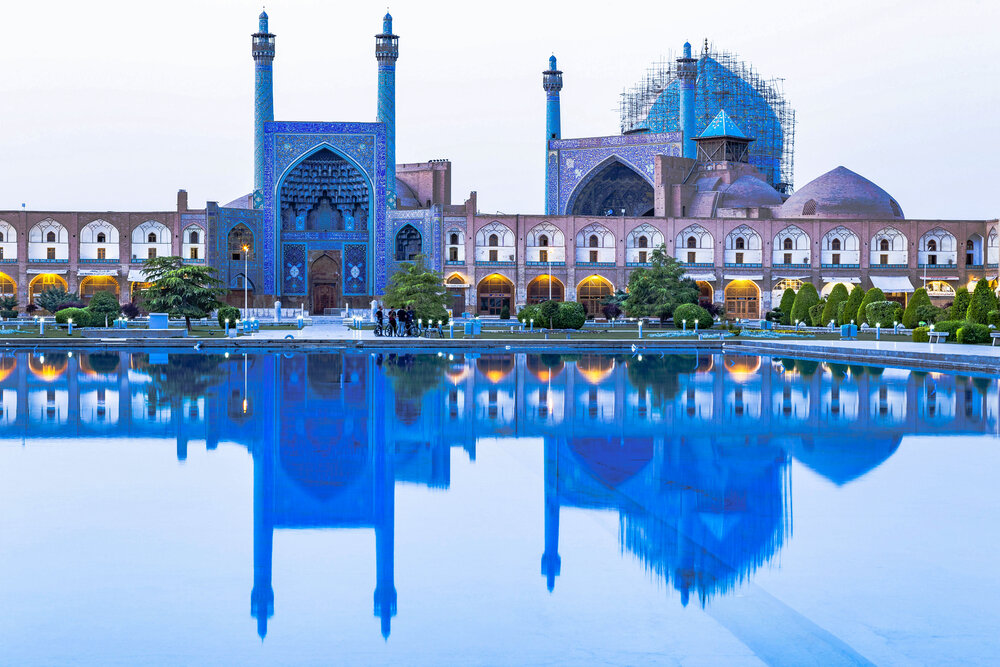Imam Mosque restoration: veteran experts recommend structural monitoring

TEHRAN–On Tuesday, a panel of veteran experts inspected Isfahan’s Imam Mosque, whose floral dome has undergone extensive restorations. They advised the cultural heritage body to launch structural monitoring for the 17th-century monument.
“A panel of elite and veteran experts in the two fields of structure and restoration comprehensively examined the whole structure of the mosque to inspect the issues with its huge and unique dome,” CHTN quoted Alireza Izadi, the provincial tourism chief, as saying on Monday.
“Therefore, due to the possibility of a structural defect in the body of this huge dome, which is designed in a two-shell form, The members of this committee, together with other veterans of Isfahan's historical monuments restoration, visited the inner spaces of the [double-shell] dome.”
The members of this specialized committee and other veterans present in this visit with the majority of votes emphasized the necessity of monitoring the main structure of the dome, the official stated.
“Especially, careful monitoring was recommended for the main dome regarding the occurrence of some possible damages, therefore planning for monitoring the main structure of the dome and its implementation will begin soon,” Izadi said.
The Ministry of Cultural Heritage, Tourism, and Handicrafts in August set up a special committee to oversee fresh restoration work to be conducted on the dome, which allegedly revealed arrays of faulty tiles when scaffoldings were removed.
At that time, Izadi said defective and problematic tiles that cause unevenness on the surface of the dome of the Imam Mosque would be replaced with the right ones.
“After the removal of a part of the scaffolding from the dome of the Imam Mosque, defects and problems in terms of unevenness were observed in some parts of it, especially in the 15th and 16th sections, and we promise the people and those interested in a cultural heritage that these issues will be resolved with care, specialized and compassionate work,” Izadi explained.
The issue was highly highlighted in July when pictures posted on social networks brought reactions about the restoration of the 17th-century dome.
Mud-brick buildings are generally more sensitive than stone structures, Izadi said. “Brick domes such as ones on Imam Mosque or Sheikh Lotfollah Mosque are not an exception to this rule, and its conditions should be fully investigated from a scientific and professional point of view.”
“When a historical building, for example, a dome, is (wholly) surrounded by scaffolding, we cannot visually identify if it is uneven… it cannot be recognized correctly.”
A masterpiece of Islamic architecture, Imam Mosque stands tall at the southern end of UNESCO-registered Naghsh-e Jahan Sq. (Imam Square) in Isfahan, central Iran. The majestic place of worship is impressive because of its sheer size and incredible decoration.
Originally named Masjed Shah (“the Shah Mosque”), its construction began in 1611 during the rule of the Safavid King Shah Abbas the Great, who reigned from 1588 to 1629. The mosque’s topmost dome was completed in the last year of his sovereignty.
Its interior and exterior walls are fully decorated with a polychrome, mostly dark blue, glazed tile revetment above a continuous marble dado. A very scenic huge entrance portal leads visitors to Imam Mosque, whose courtyard walls feature sunken porches framed by seven-colored tiles of deep blue and yellow. Each iwan leads into a vaulted sanctuary covered with particularly fine floral motifs on a blue background. Some visitors say each part of the Imam Mosque is a masterpiece that leaves a lasting impression.
Many believe each of the mosque’s parts is a work of genius that leaves a lasting impression. This palace of devotion owes its splendor mostly due to be covered with seven-color mosaic tiles and symmetrical calligraphic inscriptions.
Soaked in a colorful history, Isfahan was once been a crossroads of international trade and diplomacy in Iran and now it is one of Iran’s top tourist destinations for good reasons. It is filled with many architectural wonders, such as unmatched Islamic buildings, bazaars, museums, Persian gardens, and tree-lined boulevards. It's a city for walking, getting lost in its amazing bazaars, dozing in beautiful gardens, and meeting people.
Isfahan is renowned not only for the abundance of great historical bridges but also for its ‘life-giving river’, the Zayandeh-Rood, which has long bestowed the city an original beauty and fertility.
The city has long been nicknamed as Nesf-e-Jahan, which is translated into “half the world”; meaning seeing it is relevant to see half the world. In its heyday, it was also one of the largest cities in the region with a population of nearly one million. The cool blue tiles of Isfahan's Islamic buildings, and the city's majestic bridges, contrast perfectly with the encircling hot, dry Iranian countryside.
Imam Square is hemmed on four sides by magnificent buildings: to the east, the Sheikh Lotfollah Mosque; to the west, the palace of Ali Qapu; to the north, the portico of Qeysarieh; and to the south, the eminent Imam Mosque.
“The square was at the heart of the Safavid capital’s culture, economy, religion, social power, government, and politics. Its vast sandy esplanade was used for celebrations, promenades, and public executions, for playing polo and for assembling troops,” according to the UNESCO website.
Right at the northern limit of the Imam Square, one will find “Qeysarieh Gate”, which leads to the unique and unforgettable “Grand Bazaar of Isfahan.” This vaulted marketplace is one of the largest and most labyrinthine bazaars in the country. Shops offer handicrafts, souvenirs, jewelry, silverware, traditional ceramics, and authentic Persian carpets.
Modern Isfahan is now home to some heavy industry, including steel factories and a nuclear facility on its outskirts. However, its inner core wants to be preserved as a priceless gem. The city is also home to a gigantic, professional, and state-of-the-art healthcare city, which is a major destination in the realm of medical tourism.
AM
